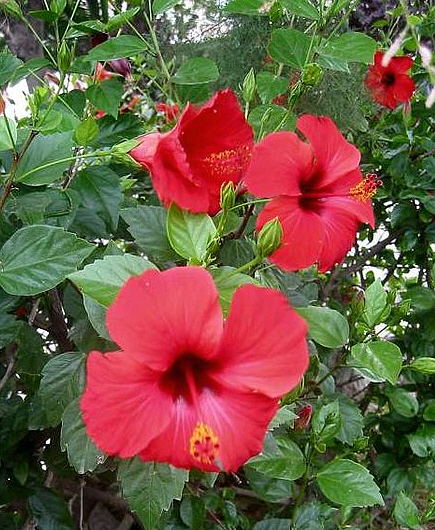

Zitierweise / cite as:
Carakasaṃhitā: Ausgewählte Texte aus der Carakasaṃhitā / übersetzt und erläutert von Alois Payer <1944 - >. -- Anhang A: Pflanzenbeschreibungen. -- Hibiscus rosa-sinensis L. -- Fassung vom 2007-07-27. -- URL: http://www.payer.de/ayurveda/pflanzen/hibiscus_rosasinensis.htm
Erstmals publiziert: 2007-07-27
Überarbeitungen:
Anlass: Lehrveranstaltung SS 2007
©opyright: Dieser Text steht der Allgemeinheit zur Verfügung. Eine Verwertung in Publikationen, die über übliche Zitate hinausgeht, bedarf der ausdrücklichen Genehmigung des Verfassers
Dieser Text ist Teil der Abteilung Sanskrit von Tüpfli's Global Village Library
Falls Sie die diakritischen Zeichen nicht dargestellt bekommen, installieren Sie eine Schrift mit Diakritika wie z.B. Tahoma.
Verwendete und zitierte Werke siehe: http://www.payer.de/ayurveda/caraka0001.htm

Abb.: Hibiscus rosa-sinensis
L. = Chinesischer Roseneibisch
[Bildquelle: Wikipedia]
Drury:
"Hibiscus Rosa sinensis (Linn.) Do. Shoe-flower plant, or China Rose, Eng. Schempariti, Mal. Sapatoo cheddie. Tam. Dasanie, Tel. Jasoon, Duk. Juva, Beng.
Description.—Shrub, 12-15 feet; stem arborescent, without prickles; leaves ovate, acuminated, coarsely toothed, and slightly cut towards the apex, entire at the base; pedicels axillary, as long as, or longer than, the leaves, jointed above their middle ; involucel 6-7 leaved ; calyx tubular, 5-cleft; flowers large, single or double, crimson, yellow, or white; seeds unknown. Fl. All the year.—W.& A. Prod. i. 49.—Rheede, ii. t. 16.—Roxb. Fl. Ind. iii. 194.------Peninsula. Cultivated in gardens.
Medical Uses.—The leaves are considered in Cochin China as emollient and slightly aperient. The flowers are used to tinge spirituous liquors, and the petals when rubbed on paper communicate a bluish-purple tint, which forms an excellent substitute for litmus-paper as a chemical test. The leaves are prescribed by the natives in smallpox, but are said to check the eruption too much.— (Don. Ainslie.) An infusion of the petals is given as a demulcent refrigerant drink in fevers.—Pharm. of India.
Economic Uses.—In China they make these handsome flowers into garlands and festoons on all occasions of festivity, and even in their sepulchral rites. The petals of the flowers are used for blacking shoes, and the women also employ them to colour their hair and eyebrows black. They are also eaten by the natives or pickles."
[Quelle: Drury, Heber <1819 - 1872>: The useful plants of India : with notices of their chief value in commerce, medicine, and the arts. -- 2d ed. with additions and corrections. London : Allen, 1873. -- xvi, 512 p. ; 22 cm. -- s.v.]